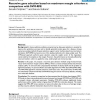80 search results - page 12 / 16 » Efficient Reinforcement Learning Using Recursive Least-Squar... |
BMCBI
2006
13 years 7 months ago
2006
Background: In class prediction problems using microarray data, gene selection is essential to improve the prediction accuracy and to identify potential marker genes for a disease...
IJCNN
2008
IEEE
14 years 1 months ago
2008
IEEE
— When an agent observes its environment, there are two important characteristics of the perceived information. One is the relevance of information and the other is redundancy. T...
ATAL
2008
Springer
13 years 9 months ago
2008
Springer
In reinforcement learning, least-squares temporal difference methods (e.g., LSTD and LSPI) are effective, data-efficient techniques for policy evaluation and control with linear v...
ML
2002
ACM
13 years 7 months ago
2002
ACM
Solving in an efficient manner many different optimal control tasks within the same underlying environment requires decomposing the environment into its computationally elemental ...
ENTCS
2010
13 years 4 months ago
2010
Fundamental nano-patterns are simple, static, binary properties of Java methods, such as ObjectCreator and Recursive. We present a provisional catalogue of 17 such nano-patterns. ...

